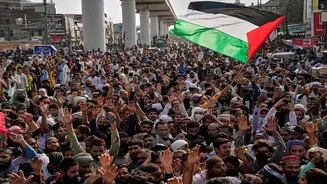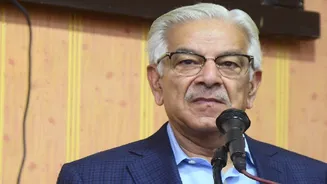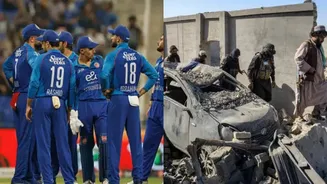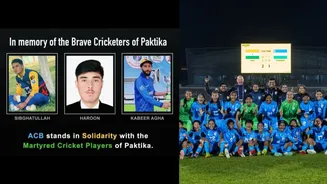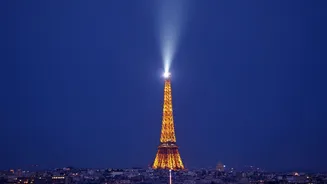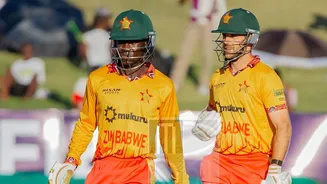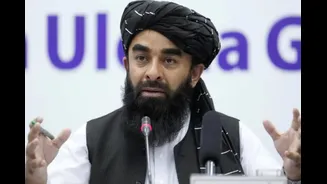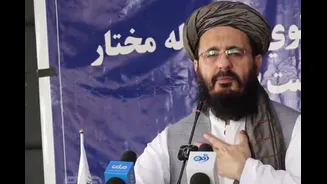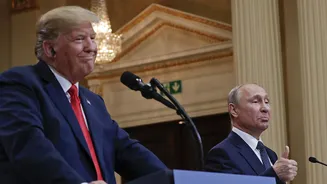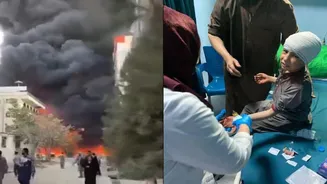What is the story about?
Pakistan witnessed another violent confrontation in early October 2025 between the state and the Tehreek-e-Labbaik Pakistan (TLP), a far-right religious party capable of mobilising thousands. What began as a pro-Palestinian rally in Lahore quickly spiralled into one of the most serious internal security crises of the year.
The government’s claim of restoring order through legitimate force stands sharply at odds with reports from eyewitnesses, independent media, and human rights observers who point to excessive violence, opaque casualty reporting, and systematic suppression of information.
The protests began as a march ostensibly aimed at expressing solidarity with Palestinians amid Israel’s ongoing offensive in Gaza. TLP, led by Saad Rizvi, called on supporters to converge in Lahore and begin a long march to Islamabad. The Punjab government, wary of the party’s history of paralysing urban centres and challenging state authority, moved preemptively to block the rally.
Containers sealed roads, internet access was throttled across major routes, and paramilitary forces were deployed in and around Muridke, the small industrial town north of Lahore that served as the focal point of the protest.
Numbers Behind the Crackdown
The situation deteriorated on October 12 when police and Rangers tried to disperse the gathering. Witnesses describe a chaotic escalation: police fired tear gas shells, rubber bullets, and, according to some accounts, live rounds into crowds that refused to disperse. Protesters responded by pelting stones, torching vehicles, and blocking highways.
Within hours, Lahore’s peripheries turned into a zone of urban combat. Footage shared on social media showed streets littered with debris, injured protesters carried on makeshift stretchers, and plumes of smoke rising from burnt police vehicles. The government initially described the event as an “anti-Israel protest gone violent”, but numbers emerging from different sources tell a more complex story.
The Punjab Police reported five fatalities, including one of their own officers, and around 110 injured law-enforcement personnel. Yet TLP officials insisted that the death toll among their cadres exceeded a dozen, later revising that number upward to several dozen. While these figures could not be independently verified, the disparity between official and partisan accounts highlights the chronic opacity in Pakistan’s handling of internal unrest.
Over the following days, the Punjab Home Department claimed to have detained more than 2,700 TLP activists. Lahore alone accounted for over 100 arrests. FIRs were lodged against Saad Rizvi and nearly 3,500 unnamed supporters, invoking sections related to terrorism, murder, and sedition. A senior police official, speaking to local media under condition of anonymity, admitted that the crackdown was “comprehensive and pre-planned”, with lists of activists circulated to district intelligence branches weeks before the march.
The state’s swift invocation of anti-terrorism laws suggests that it continues to view TLP not as a political force to be negotiated with, but as an internal security threat to be managed through coercion. The numbers tell a story of militarisation of civilian law enforcement.
According to police data released between October 14 and 16, over 4,500 personnel were deployed around Lahore, including contingents of the Rangers, an auxiliary paramilitary force technically under the Interior Ministry but often operating in coordination with the military’s corps commands.
The Punjab government justified this deployment by citing intelligence assessments of potential violence. Yet the use of paramilitary units in civilian spaces has raised renewed concerns about the blurring of civil-military boundaries in Pakistan’s governance structure. The human toll in these deadly clashes remains contested.
Hospitals in Lahore and Sheikhupura reported receiving dozens of injured protesters between October 12 and 13. A surgeon at Mayo Hospital described a “steady stream” of patients with gunshot and rubber-bullet wounds, some critical. Yet access to these medical facilities was restricted, with police posted at entrances and journalists denied entry.
The Punjab government insisted that only “a few” civilians had been seriously injured, but local rights monitors accused authorities of downplaying numbers and quietly transferring bodies to undisclosed mortuaries.
The data on arrests and injuries also reveal the asymmetry of power in this confrontation. The Punjab Police’s own figures show that more than 110 officers were injured, compared with 11 confirmed civilian fatalities. But the TLP’s claim that dozens of its workers were shot dead—unsubstantiated though it may be—cannot be dismissed outright given Pakistan’s historical record of suppressing casualty data during operations against political movements.
The 2021 and 2022 crackdowns on similar TLP marches saw comparable discrepancies between official and independent tallies, often resolved only after months of investigation. Underlying these events is a structural problem of accountability.
Pakistan’s law-enforcement architecture lacks an independent oversight mechanism to review police conduct during protests. Investigations are typically internal and opaque. The provincial government’s announcement of a “judicial inquiry” into the Lahore violence was received with scepticism, given that similar enquiries in the past have yielded little more than bureaucratic reports.
The absence of transparent, verifiable data on casualties and the use of force allows the state to maintain control over the narrative—framing unrest as terrorism rather than as a symptom of political or social alienation.
This control of information is reinforced by the suppression of digital communication. Internet blackouts, a recurring feature of Pakistan’s crisis management, were imposed across parts of Punjab during the protests. This not only hampered real-time reporting but also prevented citizens from documenting potential abuses.
According to data from NetBlocks, network connectivity in parts of Lahore dropped to less than 30 per cent of normal levels during the peak of clashes. Such shutdowns, justified by the government as necessary for public safety, effectively remove independent verification at the moments when it is most needed.
Silencing Dissent through Control
The broader political context cannot be ignored. TLP’s mobilisation capacity is significant: its support base cuts across Punjab’s urban working class, and its religious messaging resonates with segments of the population disenchanted with mainstream parties. The state’s heavy-handed tactics risk further radicalising this constituency.
Data from previous years show that TLP’s vote share in national elections, while modest (around 2.2 per cent in 2018), translated into millions of ballots cast. That scale of mobilisation suggests that repression alone cannot neutralise the movement’s appeal.
Pakistan’s repeated use of coercive force against religious movements has often backfired. Each violent encounter—whether at Faizabad, Muridke, or elsewhere—tends to reinforce TLP’s narrative of persecution by a secular, Westernised elite beholden to the military. This narrative is politically potent because it taps into deep grievances about inequality and political exclusion.
By meeting protests with bullets instead of dialogue, Pakistan risks validating the very ideology it seeks to marginalise. Economically, the protests have already taken a toll. Data from the Lahore Chamber of Commerce and Industry estimate direct losses of more than 6 billion Pakistani rupees due to road closures and disrupted logistics in the first three days alone.
Transport of goods between Karachi and northern Punjab slowed by nearly 40 per cent, according to figures from the All Pakistan Goods Transporters Association. Such disruptions compound Pakistan’s ongoing economic crisis, with inflation hovering around 27 per cent and foreign reserves barely covering two months of imports. In this context, the state’s preoccupation with domestic security comes at the expense of governance and recovery.
The military establishment’s role in shaping the response raises difficult questions about Pakistan’s civilian autonomy. Although the Lahore operation was nominally conducted by the Punjab Police, the logistical backbone—communications, coordination, and crowd-control tactics—was reportedly guided by security advisers with military backgrounds.
Analysts note that Pakistan’s hybrid political system often allows the armed forces to influence domestic policing indirectly, through both personnel interests and institutional culture. The militarisation of policing blurs lines of accountability, leaving civilians to bear the brunt of force without clear channels for redress.
Ultimately, the Lahore protests expose a deeper malaise: the inability of the Pakistani state to differentiate between dissent, disorder, and terrorism. By criminalising protest and treating mass gatherings as security threats, the state perpetuates a cycle of confrontation.
Data from Pakistan’s National Commission for Human Rights show that between 2015 and 2024, at least 2,300 people were killed in political or sectarian unrest, many during police or paramilitary operations.
Each episode erodes public trust, especially when investigations are inconclusive or absent altogether. The events of October 2025 thus stand as more than an isolated clash between TLP and the state. They reflect the structural entrenchment of coercive governance, the fusion of civil and military authority, and the erosion of transparency.
While the government insists it acted to preserve order, the opacity surrounding casualties, the mass arrests without due process, and the continuing suppression of communication networks paint a more troubling picture—one where control overrides accountability.
Unless Pakistan develops credible mechanisms to ensure transparency in security operations and to separate civilian policing from military influence, such confrontations will continue to recur, each one deepening the fissures within society. The Lahore crackdown is a symptom of a state that measures stability through silence, not consent. Its data, fragmented and contested, tell a story less of control than of a nation perpetually at war with its own citizens.
Tehmeena Rizvi is a policy analyst and PhD scholar at Bennett University. Her areas of work include Women, Peace, and Security (South Asia), focusing on the intersection of gender, conflict, and religion, with a research emphasis on the Kashmir region, Pakistan, and Afghanistan. Views expressed are personal and do not necessarily reflect Firstpost’s editorial stance.
The government’s claim of restoring order through legitimate force stands sharply at odds with reports from eyewitnesses, independent media, and human rights observers who point to excessive violence, opaque casualty reporting, and systematic suppression of information.
The protests began as a march ostensibly aimed at expressing solidarity with Palestinians amid Israel’s ongoing offensive in Gaza. TLP, led by Saad Rizvi, called on supporters to converge in Lahore and begin a long march to Islamabad. The Punjab government, wary of the party’s history of paralysing urban centres and challenging state authority, moved preemptively to block the rally.
Containers sealed roads, internet access was throttled across major routes, and paramilitary forces were deployed in and around Muridke, the small industrial town north of Lahore that served as the focal point of the protest.
Numbers Behind the Crackdown
The situation deteriorated on October 12 when police and Rangers tried to disperse the gathering. Witnesses describe a chaotic escalation: police fired tear gas shells, rubber bullets, and, according to some accounts, live rounds into crowds that refused to disperse. Protesters responded by pelting stones, torching vehicles, and blocking highways.
Within hours, Lahore’s peripheries turned into a zone of urban combat. Footage shared on social media showed streets littered with debris, injured protesters carried on makeshift stretchers, and plumes of smoke rising from burnt police vehicles. The government initially described the event as an “anti-Israel protest gone violent”, but numbers emerging from different sources tell a more complex story.
The Punjab Police reported five fatalities, including one of their own officers, and around 110 injured law-enforcement personnel. Yet TLP officials insisted that the death toll among their cadres exceeded a dozen, later revising that number upward to several dozen. While these figures could not be independently verified, the disparity between official and partisan accounts highlights the chronic opacity in Pakistan’s handling of internal unrest.
Over the following days, the Punjab Home Department claimed to have detained more than 2,700 TLP activists. Lahore alone accounted for over 100 arrests. FIRs were lodged against Saad Rizvi and nearly 3,500 unnamed supporters, invoking sections related to terrorism, murder, and sedition. A senior police official, speaking to local media under condition of anonymity, admitted that the crackdown was “comprehensive and pre-planned”, with lists of activists circulated to district intelligence branches weeks before the march.
The state’s swift invocation of anti-terrorism laws suggests that it continues to view TLP not as a political force to be negotiated with, but as an internal security threat to be managed through coercion. The numbers tell a story of militarisation of civilian law enforcement.
According to police data released between October 14 and 16, over 4,500 personnel were deployed around Lahore, including contingents of the Rangers, an auxiliary paramilitary force technically under the Interior Ministry but often operating in coordination with the military’s corps commands.
The Punjab government justified this deployment by citing intelligence assessments of potential violence. Yet the use of paramilitary units in civilian spaces has raised renewed concerns about the blurring of civil-military boundaries in Pakistan’s governance structure. The human toll in these deadly clashes remains contested.
Hospitals in Lahore and Sheikhupura reported receiving dozens of injured protesters between October 12 and 13. A surgeon at Mayo Hospital described a “steady stream” of patients with gunshot and rubber-bullet wounds, some critical. Yet access to these medical facilities was restricted, with police posted at entrances and journalists denied entry.
The Punjab government insisted that only “a few” civilians had been seriously injured, but local rights monitors accused authorities of downplaying numbers and quietly transferring bodies to undisclosed mortuaries.
The data on arrests and injuries also reveal the asymmetry of power in this confrontation. The Punjab Police’s own figures show that more than 110 officers were injured, compared with 11 confirmed civilian fatalities. But the TLP’s claim that dozens of its workers were shot dead—unsubstantiated though it may be—cannot be dismissed outright given Pakistan’s historical record of suppressing casualty data during operations against political movements.
The 2021 and 2022 crackdowns on similar TLP marches saw comparable discrepancies between official and independent tallies, often resolved only after months of investigation. Underlying these events is a structural problem of accountability.
Pakistan’s law-enforcement architecture lacks an independent oversight mechanism to review police conduct during protests. Investigations are typically internal and opaque. The provincial government’s announcement of a “judicial inquiry” into the Lahore violence was received with scepticism, given that similar enquiries in the past have yielded little more than bureaucratic reports.
The absence of transparent, verifiable data on casualties and the use of force allows the state to maintain control over the narrative—framing unrest as terrorism rather than as a symptom of political or social alienation.
This control of information is reinforced by the suppression of digital communication. Internet blackouts, a recurring feature of Pakistan’s crisis management, were imposed across parts of Punjab during the protests. This not only hampered real-time reporting but also prevented citizens from documenting potential abuses.
According to data from NetBlocks, network connectivity in parts of Lahore dropped to less than 30 per cent of normal levels during the peak of clashes. Such shutdowns, justified by the government as necessary for public safety, effectively remove independent verification at the moments when it is most needed.
Silencing Dissent through Control
The broader political context cannot be ignored. TLP’s mobilisation capacity is significant: its support base cuts across Punjab’s urban working class, and its religious messaging resonates with segments of the population disenchanted with mainstream parties. The state’s heavy-handed tactics risk further radicalising this constituency.
Data from previous years show that TLP’s vote share in national elections, while modest (around 2.2 per cent in 2018), translated into millions of ballots cast. That scale of mobilisation suggests that repression alone cannot neutralise the movement’s appeal.
Pakistan’s repeated use of coercive force against religious movements has often backfired. Each violent encounter—whether at Faizabad, Muridke, or elsewhere—tends to reinforce TLP’s narrative of persecution by a secular, Westernised elite beholden to the military. This narrative is politically potent because it taps into deep grievances about inequality and political exclusion.
By meeting protests with bullets instead of dialogue, Pakistan risks validating the very ideology it seeks to marginalise. Economically, the protests have already taken a toll. Data from the Lahore Chamber of Commerce and Industry estimate direct losses of more than 6 billion Pakistani rupees due to road closures and disrupted logistics in the first three days alone.
Transport of goods between Karachi and northern Punjab slowed by nearly 40 per cent, according to figures from the All Pakistan Goods Transporters Association. Such disruptions compound Pakistan’s ongoing economic crisis, with inflation hovering around 27 per cent and foreign reserves barely covering two months of imports. In this context, the state’s preoccupation with domestic security comes at the expense of governance and recovery.
The military establishment’s role in shaping the response raises difficult questions about Pakistan’s civilian autonomy. Although the Lahore operation was nominally conducted by the Punjab Police, the logistical backbone—communications, coordination, and crowd-control tactics—was reportedly guided by security advisers with military backgrounds.
Analysts note that Pakistan’s hybrid political system often allows the armed forces to influence domestic policing indirectly, through both personnel interests and institutional culture. The militarisation of policing blurs lines of accountability, leaving civilians to bear the brunt of force without clear channels for redress.
Ultimately, the Lahore protests expose a deeper malaise: the inability of the Pakistani state to differentiate between dissent, disorder, and terrorism. By criminalising protest and treating mass gatherings as security threats, the state perpetuates a cycle of confrontation.
Data from Pakistan’s National Commission for Human Rights show that between 2015 and 2024, at least 2,300 people were killed in political or sectarian unrest, many during police or paramilitary operations.
Each episode erodes public trust, especially when investigations are inconclusive or absent altogether. The events of October 2025 thus stand as more than an isolated clash between TLP and the state. They reflect the structural entrenchment of coercive governance, the fusion of civil and military authority, and the erosion of transparency.
While the government insists it acted to preserve order, the opacity surrounding casualties, the mass arrests without due process, and the continuing suppression of communication networks paint a more troubling picture—one where control overrides accountability.
Unless Pakistan develops credible mechanisms to ensure transparency in security operations and to separate civilian policing from military influence, such confrontations will continue to recur, each one deepening the fissures within society. The Lahore crackdown is a symptom of a state that measures stability through silence, not consent. Its data, fragmented and contested, tell a story less of control than of a nation perpetually at war with its own citizens.
Tehmeena Rizvi is a policy analyst and PhD scholar at Bennett University. Her areas of work include Women, Peace, and Security (South Asia), focusing on the intersection of gender, conflict, and religion, with a research emphasis on the Kashmir region, Pakistan, and Afghanistan. Views expressed are personal and do not necessarily reflect Firstpost’s editorial stance.
Do you find this article useful?
